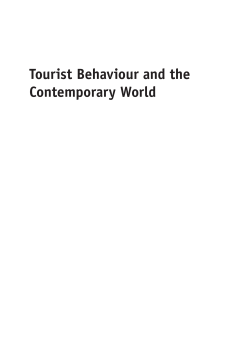
Additional Information
Book Details
Abstract
This volume seeks to review and stimulate interest in a number of emerging and fresh topics in contemporary tourist behaviour and experience. Topics explored include the effects of newer technologies on tourists’ behaviour and experience, tourists’ experience of scams, safety and personal responsibility, individual perspectives on sustainability, and some dimensions of tourists’ personal growth, relationships and altruism. The topics are bound together by an integrative approach to conceptualising experience which is seen as an ensemble of orchestrated sensory inputs; affective reactions; cognitive mechanisms used to think about and understand the setting; actions undertaken and the relevant relationships which define the participants’ world. A special emphasis is placed on tourists’ stories as a pathway to access the nature of tourists’ experience. Potential research directions in the field are indicated throughout.
Philip L. Pearce is Foundation Professor of Tourism at James Cook University, Australia. His research focuses on tourist behaviour, notably tourist motivation and experience, tourism and communities and tourism education and research.
This is an important book on many levels. It addresses fascinating issues related to contemporary tourist behavior in a very accessible and yet rigorous manner. It will enlighten many audiences from researchers and students to more general readers. From the first excellent chapter on research approaches to the intriguing journey through the remaining chapters, the author gently and yet powerfully guides his readers to deeper understandings of important shifts in tourist behavior.
Philip Pearce has once again offered us a remarkably broad and in-depth treatment of the issues shaping the world of tourism today. In this book you will find a concise and integrated summary of what we know, as well as what we need to know on a whole range of topics. The book is a must-read for tourism researchers in assessing new and emerging research streams that will make a difference.
The author is successful in bringing both the theory and the practice together by supporting each case either with the illustration of personal observations or the summary of an early study findings. The book will be of help to the readers to expand the capacity of their existing knowledge on tourist behaviour with a list of additional approaches to take further steps in the direction of opening new lines of research topics in the near future. In saying so, the audience of this book may include tourism researchers such as faculty and postgraduate students worldwide. In addition, practitioners can also largely benefit from case studies and their utilization to create a more positive tourism experience out of their service offerings.
Metin Kozak, Dokuz Eylul University, Turkey in TOURISM RECREATION RESEARCH VOL. 38(1), 2013: 117–123
The field of tourism studies has grown to the extent that researchers are seeking new topics, models, and approaches. This concise volume attempts to fill this role. Pearce (tourism, James Cook Univ., Australia) provides a broad-ranging survey and discussion of understudied topics in the field of tourism research. The author writes from a multidisciplinary perspective, but his background in psychology comes through with topics such as tourist motivations, emotional reactions, behaviors, satisfaction, and learning. As a handbook for researchers and students, the volume works well by including a breadth of topics: the effects of newer technologies on the tourist experience, tourist safety, patterns of tourist movement, volunteer tourism, tourist ecological footprint, slow tourism, and more.
Table of Contents
| Section Title | Page | Action | Price |
|---|---|---|---|
| Contents | v | ||
| Preface | vii | ||
| 1 Pathways to Understanding | 1 | ||
| 2 The Digital Tourist | 25 | ||
| 3 The Tourist in Trouble | 57 | ||
| 4 The Tourists’ Footprints | 83 | ||
| 5 Dimensions of Personal Change | 109 | ||
| 6 Tourists Connecting to Others | 135 | ||
| 7 Additional Perspectives | 150 | ||
| References | 162 | ||
| Index | 183 |
